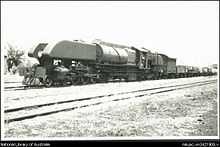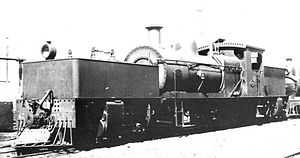Australian Standard Garratt
| Australian Standard Garratt | |
|---|---|
|
ASG No. G33 as preserved, 2007 | |
| Type and origin | |
| Power type | steam |
| Build date | 1943–1945 |
| Total produced | 65 |
| Specifications | |
| Configuration | 4-8-2+2-8-4 |
| Gauge | 3 ft 6 in (1,067 mm) |
| Driver diameter | 48 in (1,219 mm) |
| Length | 85 ft 9 1⁄2 in (26.15 m) |
| Axle load | 8.5 long tons (8.6 t; 9.5 short tons) |
| Weight on drivers | 76.25 long tons (77.5 t; 85.4 short tons) |
| Locomotive weight | 119 long tons (120.9 t; 133.3 short tons) |
| Fuel type | Coal |
| Fuel capacity | 6 long tons (6.1 t; 6.7 short tons) |
| Water capacity | 4,200 imp gal (19,094 l; 5,044 US gal) |
| Boiler pressure | 200 psi (1,379 kPa) |
| Firegrate area | 35 sq ft (3 m2) |
| Heating surface: – Total | 2,013 sq ft (187 m2) |
| Cylinders | Four, outside |
| Cylinder size | 14.5 in × 24 in (368 mm × 610 mm) |
| Performance figures | |
| Tractive effort | 34,240 lbf (152.3 kN) |
The Australian Standard Garratt (ASG) was a Garratt steam locomotive designed in Australia during the Second World War, and used on 3 ft 6 in (1,067 mm) narrow gauge railway systems in Queensland, South Australia, Western Australia and Tasmania.
Overview
The 3 ft 6 in (1,067 mm) narrow gauge Australian Standard Garratt (ASG) of 1943, a 4-8-2+2-8-4 locomotive, was designed during the crisis period of World War II immediately following the bombing of Darwin. As an emergency measure the Commonwealth Land Transport Board commissioned a team of engineers led by Western Australian Government Railways (WAGR) Chief Mechanical Engineer, Frederick Mills, to design the new class of Garratt, which was to bolster the inadequate fleet of locomotives on Australia's extensive narrow gauge rail systems.[1] The Australian government had sought to obtain drawings and licenses from Beyer, Peacock and Company but that was denied.[2]
The class of 57 locomotives (out of a planned 65) was designed in 1942 and built from scratch within four months in 1943. Construction lasted until 1945.[2] The locomotives were produced by the WAGR's Midland Railway Workshops, the Victorian Railways Newport Workshops, and the South Australian Railways Islington Workshops, as well as the private firm Clyde Engineering. The locomotives delivered 34,521 lbf (153,560 N) of tractive effort.
Usage and problems
Because of differences between the states, especially in regard to loading gauges, the sharpness of curves, and axle load, especially in Queensland, the design had to be a compromise, which went against the idea of having a standardised design.
Although produced for heavy work during war-time, few engines lasted through the 1950s, and most were scrapped in that decade. On the other hand, the locomotives were successful on the private Emu Bay Railway in Tasmania.
A major flaw in the Australian design was that the leading driving wheels were flangeless, which caused derailments on curves and points. Another key problem, which made the locomotives unpopular with locomotive crews, was the fact that the firebox door opened flat on the floor of the driving cab, maximising heat radiation into the crew compartment.
Queensland and South Australia both purchased much more successful designs of Garratt engines from Beyer-Peacock, post-war, which lasted until the end of steam.

Twenty-three ASGs saw service in Queensland, where crews eventually refused to work them and they were withdrawn.[2]
The South Australian Railways operated six ASGs on the Peterborough Division where they formed the 300 Class. They were assembled by the Victorian Railways Newport Workshops (300 and 303) and the WAGR's Midland Railway Workshops (301, 302, 304, 305). Their primary task was haulage of lead ore between Cockburn and Port Pirie. As on other narrow gauge systems, the ASGs were unpopular with SAR crews.[3]
In Western Australia twenty-five ASGs saw service.[2] They also proved unpopular with crews, and their use through the state's only tunnel at Swan View caused serious problems, resulting in deaths, industrial disputes,[4] and a Royal Commission.[5][6]
In Tasmania, following modifications, the ASG locomotives remained in government railway service until 1957. The Emu Bay Railway[7] also utilised ASG engines with success until 1966.[2] Tasmania, by coincidence, had been the first state to run Garratt locomotives; the TGR K Class (K1 and K2).
In Victoria, only one ASG is known to have been used, on the Fyansford Cement Works Railway near Geelong. The locomotive was withdrawn in 1966 and donated to the Geelong division of the Australian Railway Historical Society.[2] It was on static display at the Williamstown Railway Museum until May 2013, when it was relocated to the Bellarine Railway and is expected to return to steam in 2014 or 2015.[8]
Brakes
Couplings
- Buffers and Chain – Queensland and Tasmania (though not necessarily the same width)
- Norwegian (Chopper) – Western Australia, Victoria and South Australia (though not necessarily compatible)
Locomotive fleet
Preservation
The only surviving complete ASG is G33, which was built at the Victorian Railways' Newport Workshops in 1945 and ran on the Fyansford Cement Works Railway until 1966. It was on static display at the Australian Railway Historical Society (ARHS) Railway Museum in North Williamstown, Victoria.
However, in late 2011 it was announced that a lease agreement had been reached between the ARHS and the Bellarine Railway which would see G33 relocated to the Bellarine Railway's Queenscliff base, and restored to running condition.[10][11] On 30 and 31 May 2013, the various components of G33, along with a spare boiler, were moved by road from the ARHS Museum to Queenscliff.[12]
Many front ASG water tanks have survived; one at Yatina, South Australia, and two on a farm south of Peterborough, South Australia. Two at Don River Railway in Tasmania and several dotted around the state. These survived as water tanks for steam and firefighting tanks until the early 1980s.
A boiler also survives with the Derwent Valley railway in New Norfolk, Tasmania.
See also
- List of Western Australian locomotive classes
- Locomotives of the Tasmanian Government Railways/1950
- Minimum railway curve radius
- Msa garratt of WAGR
References
- ↑ Gunzburg 1984, p. 121.
- ↑ 2.0 2.1 2.2 2.3 2.4 2.5 Oberg, Leon (1975). Locomotives of Australia. Sydney: A.H. & A.W. Reed. ISBN 0 589 07173 4.
- ↑ Fluck R., Sampson R., Birb K., Steam Locomotives and Railcars of the South Australian Railways, Mile End Railway Museum, 1986. ISBN 0-9595073-3-7
- ↑ "'Now What Has She Got That 400 Others Haven't Got?'.". The Mirror (Perth: National Library of Australia). 4 March 1944. p. 18. Retrieved 13 October 2012.
- ↑ Some Aspects of the Australian Standard Garratt Locomotive Minchin, R.S. Australian Railway Historical Society Bulletin, April, 1979 pp69-77
- ↑ Wolff, Albert Asher (1946). Report of the Royal Commission appointed to inquire into Australian Standard Garratt. Perth: William H Wyatt, Government Printer. Retrieved 2 November 2014.
- ↑ Knowles, J.W., The Australian Standard Garratt on the Emu Bay Railway, Australian Railway Historical Society Bulletin, March, 1995 pp. 59-66
- ↑ "Get G33 Moving". Bellarine Railway.
- ↑ 9.0 9.1 9.2 9.3 9.4 9.5 300 Class
- ↑ Association of Tourist Railways (Victoria) – October 2011 newsletter
- ↑ "Get G33 Moving appeal". Bellarine Railway. Retrieved 2012-12-10.
- ↑ "Get G33 Going Update". The Bellarine Railway. Retrieved 2013-06-05.
Bibliography
- Barry, Kevin (1996-12), "Labour divided: the Garratt strike of 1946", Papers in Labour History (17): 46–67, ISSN 1030-6218 Check date values in:
|date=(help) - Butrims, Robert; Australian Railway Historical Society. Victorian Division; Geelong Steam Preservation Society (1975), Australia's Garratt, Geelong Steam Preservation Society in conjunction with Australian Railway Historical Society, Victorian Division, ISBN 978-0-9598322-0-4
- Durrant, A E (1981). Garratt Locomotives of the World (rev. and enl. ed.). Newton Abbot, Devon, UK; North Pomfret, Vt, USA: David & Charles. ISBN 0715376411.
- Gunzburg, Adrian (1968). WAGR Locomotives 1940–1968. Perth: Australian Railway Historical Society (Western Australian Division). pp. 10–12, 47. OCLC 219836193.
- Gunzburg, Adrian (1984). A History of WAGR Steam Locomotives. Perth: Australian Railway Historical Society (Western Australian Division). ISBN 0959969039.
- Oberg, Leon (1975), Locomotives of Australia, A.H. and A.W. Reed, ISBN 978-0-589-07173-8
External links
| Wikimedia Commons has media related to Australian Standard Garratt. |
- Operating Manual for Australian Standard Garratt
- Forum discussion of whereabouts of former ASG tanks
| |||||||||||||||||||||||||||||||||||||
| ||||||||||||||||||||||||||||||||||||||||||

